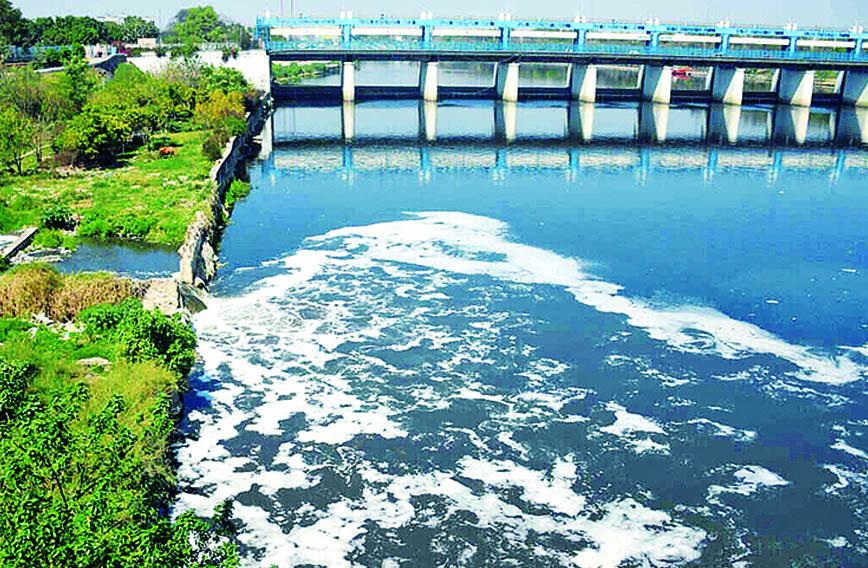
VENKATESH DUTTA
Right through the heart of Lucknow, the Gomti river once flowed like a living artery — nourishing farms, recharging water reserves and shaping the cultural and ecological identity of the region, without any obstruction. Today, that river is suffocated under the heavy weight of development. What has happened to the Gomti is not an ordinary event, but a story of planned cultural and human degradation — written by planners and land developers who saw neither life nor rights in the river, only real estate possibilities.
The deception began with the creation of Gomti Nagar — a township built on the river’s own floodplain drained by two small rivers, the Kukrail and the Sahiri. Land that nature had given to the river to handle seasonal overflows, recharge groundwater and sustain the wetlands along the river was cut, levelled and sold for commercial and residential projects. From that moment on, the Gomti’s expanse, its breath, its survival, became subject to the innumerable demands of a growing city.
Then, gradually, the city’s fury grew on its tributaries. The many small rivers that once fed the Gomti with fresh water, such as the Kukrail, Behta, Bakh, Nagwa and Sai, were one by one converted into open sewers. These were not just waterways, but living ecosystems in their own right. Their destruction ensured that the Gomti would now be fed by untreated wastewater rather than rain and run-off.
The recharge areas — wetlands, ponds and lakes — were filled with colonies, roads and offices, approved by the same officials whose job was to maintain balance through planned development in the city. The Lucknow Development Authority, instead of protecting the city’s water storage system, left no stone unturned in wiping it out.
The riverfront development project, launched with much fanfare, struck another deadly blow. In the name of decoration, the natural banks of the Gomti were shielded by a concrete wall. Sand dunes, turtle and fish habitats, and vegetation along the banks were all levelled. What remained was a canal decorated with lighting and landscaping — a river reduced to mere display.
To tackle the rising pollution, an interceptor drain was planned, aimed at taking the city’s raw sewage away from the river. But the project failed on both technical and implementation fronts. Today, raw sewage continues to flow into the Gomti, and the drain itself has become a symbol of misplaced priorities and faulty planning.
Not content with this loss, the planners did not hold back from encroaching on the remaining open spaces of the river. Vast stretches of the banks were allotted for commercial development. With every piece of land sold, the river lost another part of itself. The Gomti kept getting torn apart and we kept patting ourselves on our backs in the smart city race.
And now another deadly attack has come from a project, which was given the deceptive name of “Green Corridor”. In reality, this is not a green area, this project is a plan for a rapid multi-lane road designed along the Gomti in the middle of the last remaining floodplain of the river. It has been designed to connect IIM Road to Shahid Path and Kisan Path, in which even the last remaining breathing space of the river has not been spared.
First the river was confined and a dam was built, then a concrete riverfront in the belly of the river and now the Green Corridor. Lucknow will crave water. Just let the temperature rise two degrees more. Shahid Path, Kisan Path, Ring Road and a new four-lane in the middle of the city, vehicles and hooters will run but benzene and petrol will mix in its breath. Perhaps, in 365 days, clean air will not be available for even 65 days.
In a city that already has the highest road density of any city in the country, was another expressway really needed in the riverine area? It is not green at all — it is grey concrete, and will turn black with time. Even the protected forests within Lucknow Cantonment, which have long remained undisturbed by people, are now under threat.
The story of the Gomti is the story of a dying river, symbolic of our broader failure: the inability of our cities to integrate ecological wisdom and urban ambition. Each intervention — whether it is a township, a riverfront, an interceptor drain or a green corridor highway — has strangled the Gomti, fragmenting and isolating it, without regard for the fact that the river is a living system. The result is that today the Gomti is no longer a river, but a waste-carrying route and a platform for real estate-concrete.
What the Gomti needs is not another project, but a cleansing of our mindsets. We need to see our rivers as living systems — reviving the Gomti will mean restoring its floodplains, its tributaries and, most important, its dignity. Until we do that, every ribbon cut to inaugurate schemes and every foundation laid on its banks will not be a symbol of progress but a reminder of all the important things we have chosen to forget. ν
Venkatesh Dutta is a Gomti River Waterkeeper and a professor of environmental sciences at Ambedkar University, Lucknow
Comments
Currently there are no Comments. Be first to write a comment!




